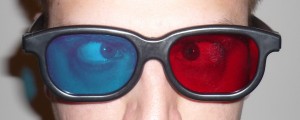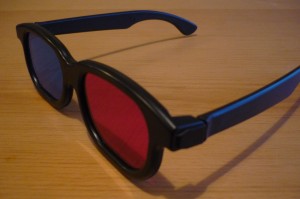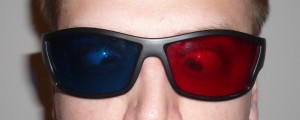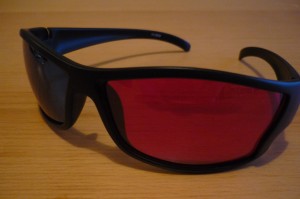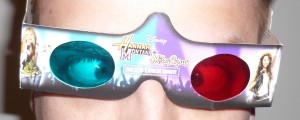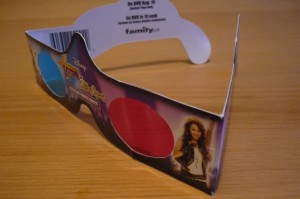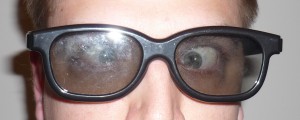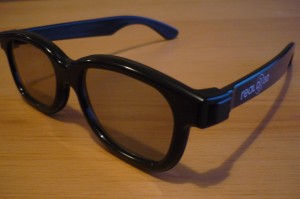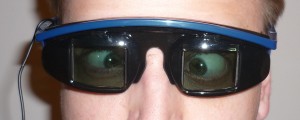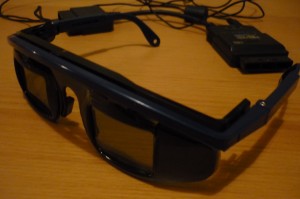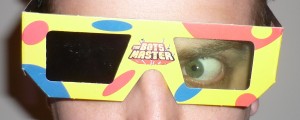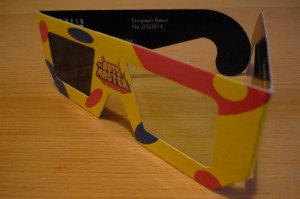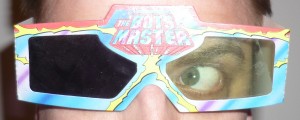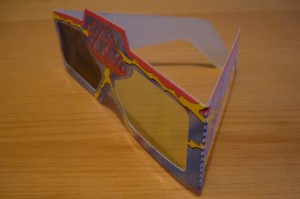Powet Alphabet: T is for 3D
by Adam, filed in Games, Movies, Powet Alphabet on May.15, 2010

Since the alphabet is the building block of our language, the Powet Alphabet is the building block of what makes us geeks.
The whole world is 3D, so maybe I should be more specific. This article is to discuss the optical effect of making something appear 3D to a human viewer. This effect can be done a number of ways, but in pretty much all instances this is achieved by having each eye see a different image to create the illusion of depth.
Close one eye at a time and you’ll see that each eye sees something slightly different. This is the real trick to 3D called paralax. The left eye needs to see an image as it would appear from a few inches to the left than the right eye and your brain is smart enough to use this to extrapolate depth. An easy way of showing this to be the real source of the effect is to try closing one eye while using pretty much any kind of 3D technology, and you will see the effect disappear.
The most iconic type of 3D glasses are used to view what is called an anaglyph. This 3D effect uses coloured lenses on glasses to create a different image in each eye. The typical glasses used for this have one red eye and one blue eye. The most basic images that can be viewed with this effect are 2 black and white images superimposed with one being red and the other being blue so that the red eye only sees the blue image and the blue eye only sees the red image. This is common in old sticker books as it’s an easy trick to reproduce with inexpensive printing. Similarly, since it only uses simple colours, this effect is easily reproduced in images or video regardless of the medium.
This effect can be done to colour images as well, and this can be seen with most of the home video 3D movies that have been released in the past like the Hannah Montana & Miley Cyrus: Best of Both Worlds Concert or Spy Kids 3D. The particular refresh rate of an LCD, plasma or CRT TV won’t have any effect on this effect. The down side here is that without using a purely black and white image as the source there will be some amount ghosting from one image to another which can be quite distracting.
If you do have a pair of blue and red 3D glasses, please put them on to check out these images I made back in the day:
To get better colour in 3D other options are needed, and lately polarization is a good way to do this. It’s hard to explain how this works without explaining polarization… so here we go…
Light is a wave. Think of it as a tiny particle bobbing up and down as it travels through the air, with the frequency at which it does so determining it’s colour, though that’s not really relevant. It doesn’t really matter in which orientation that wave travels, you will still see that image as light when it hits the back of your eye. Using specialized glass you can block out light which has waves with certain orientations and not others. This is what your 3D glasses do. The trick is to get the image to be projected in such a way that the image that is to be seen by one eye, through one filter, is composed of light with a certain polarization, and the image to be seen by the other eye has another orientation. This can be done easily, or very expensively.
The easy way to do it uses normal projectors, you just need two of them. You put a filter on one camera that only lets through the light that one eye sees and you put a filter on the other camera that only lets through the light the other eye sees. This has a few draw backs. The need for two cameras. The difficulty in synching them, but it does in a pinch when you don’t want to go rehauling your entire theatre. This simple technology was widely used during the 3D craze of the early 1950s.
Then there’s the complicated fancy way that the RealD 3D theatres use. If you didn’t see Avatar in IMAX and got to keep the glasses, this is probably what you say. Basically, something called circular polarization is used. This is best illustrated with an image, but basically the the polarization is constantly rotating in a circular motion. The image to be seen in one eye has a circular polarization in one direction and the other eye has it done in the other direction. This avoids problems with standard polarized lenses which cause them to behave differently when the viewer’s head is tilted.
I hope I’ve thoroughly confused everyone. It goes without saying that polarized 3D is a bit complicated, so if you are looking for a proper explanation I would suggest checking out a few of these links for more detailed information:
Wikipedia: Polarizer
Wikipedia: Circular Polarization
A simple method which blocks out one eye at a time is called the eclipse method. This can be done with LCD technology which makes one of the lenses opaque at a time at a very high rate. This is the method used by the new 3D TVs that will be hitting the market shortly and is also what is seen in IMAX 3D theatres. The TVs required to do this must have a high refresh rate to look decent, so 120hz TVs are capable of having a 60hz 3D image since only half the frames are seen in each eye. The draw back of this technology is that the glasses need to have electronics in them to black out one lens at a time and they need to be properly synched with the source video. This is pretty much why you’re not allowed to take your IMAX 3D glasses but you’re allowed to RealD 3D glasses.
3D video games being developed for these types of TVs must be made to compensate for this lowered frame rate. To use the same processing power to render a 1080p 60hz game in 3D will require either reducing the visible frame rate by half or alternatively reducing the resolution in order to double the effective frame rate to maintain the same smoothness. A 1080p game will likely to rendered at 720p to preserve the same frame rate. Games already rendered at 720p may be rendered at even lower resolution, and then upscaled to appear to be 720p just to look smooth.
You don’t actually need a fancy TV to do this, as old CRTs can do it, though naturally they will suffer from a lot of flicker from the low frame rate. A simple device called the Split Fish Eye FX 3D was made for the PS2 which uses the eclipse method with a device which manually changes the game’s camera angle many times per second by overriding the controller port. The effect is very effective, though the seizure enduringly low frame rate can be quite annoying and not all games work with it. Like with the NES zapper it won’t work on anything but an old CRT. Ironically, if HDTVs had never become common we would be able to have 3D games today without needing to “upgrade” to 3D TVs, though we would have the low frame rate to contend with. So much to say, there’s nothing inadequate about the frame rate of newer HDTV as 3D goes, it’s mostly just the whole synching up with the glasses properly thing which is a challenge.
A draw back of all these 3D technologies is that the image will look like garbage without wearing the 3D glasses. It’s really not an option to watch Avatar in 3D and then just decide you don’t feel like watching it like that and taking off your glasses, though closing one eye will do the trick.
When it comes to 3D on broadcast TV, it’s just a bad idea to broadcast something that viewers without the 3D glasses can’t watch without the annoying double image for a number of reasons. TV is a more passive medium than film, so people like to watch it while doing other things, or not watching it at all. You also can’t expect people to buy 3D glasses just to watch a show or event. This is the challenge that the 1992 TV series “The Bots Master” tackled quite well by using a technique known as the Pulfrich Effect.
The Pulfrich Effect creates 3D based on a simple concept, the human brain is capable of processing a brighter image faster than a darker image. Although the lenses for a 3D show like the Bots Master are different colours, it’s not the colour which creates the illusion, but the fact that the images seen in one lens are slightly darker than the other. So what you see is that the image seen from the brighter lens will be seen by your brain faster than the image seen through the darker lens. The image perceived through the darker lens will actually be from slightly further back in time than the image your brain is simultaneously perceiving through the brighter lens.
How exactly does this create the illusion of 3D? Static images can not be used to create this effect, but moving images can. By having different layers moving at different speeds on the screen, an image that is slightly more recent, and seen first through one eye, appears to be seen from a slightly different perspective than the other. In the Bots Master this illusion is achieved through animation with different layers moving all the time. This can be achieved using a video camera but the camera needs to be moving in order to make the effect work. This effect can be very distracting as it’s not really normal to have objects constantly moving on screen but it does have the effect of allowing viewers with or without 3D glasses to be able to appreciate the effect.
The opening credits to the Bots Master appear normal without glasses, but when viewed with one dark and one bright lens the different speeds of all of the layers of animation create the illusion of depth
Regardless of the techniques used to recreate the 3D, there’s a huge difference between different 3D films. There’s a good technical reason for which Avatar is simply superior to tripe like Clash of the Titans and Alice in Wonderland.
When Avatar was filmed special 3D cameras were used. I’m sure I could include some really detailed explanation of how that works, but basically think of it as two cameras. In order to accurately film something which should be seen by two different eyes, you need two different cameras! Simple enough.
Well there are lazy people out there who want to do a cash grab with 3D but don’t want to actually go through the trouble of shooting in 3D. I first encountered this filth when I had the misfortune of watching “Harry Potter and the Order of the Phoenix” in what was being advertised as IMAX 3D. What was done to a few scenes in this film, and what was done to many recent 3D cash grabs, is a travesty to cinema. Basically, after the film had been done in 2D with a single camera, post production work is done to the image to create the illusion of 3D. This mostly means manually taking parts of the image that should be in front of others and creating a resulting set of images where these will be perceived by each eye as being slightly off center. The end result is not a convincing 3D effect to anyone who’s spent more than a few hours in the real world. While the people themselves are at different depths, they will often still be in 2D, or otherwise parts of the people will be at different depths, making them all look like paper cutouts who’s hands are sticking out of the screen.
Unfortunately, people are idiots. Alice in Wonderland and Clash of the Titans, while not as successful as Avatar, were huge commercial successes. Movie studios who only care about making money will be perfectly content in putting out this drivel while we can only hope that some respectful filmmakers will take a stand against it by insisting their films are either done in proper 3D or not at all. Michael Bay, for all the criticism he’s gotten, seems adamant about not making a Transformers movie in fake 3D. On the other hand we have filmmakers like Ridley Scott who would rather take a chance on 3D with an Alien movie and see how it turns out than take the time to see if it’s a viable option ahead of time.
It remains to be seen if 3D movies are here to stay or if they’re a gimmick we’ll get sick of in a few years. While I find the technology interesting I ultimately find it distracting in a full length film, but I have much more respect for the James Camerons of the world who chose to treat the technology with some amount of respect than those who are just interested in a quick buck.
Would you like to see every romantic comedy in 3D, just your special effects masterpieces sci fi movies or nothing at all? Leave a comment and let us know what you think.


 PS3
PS3
 Famicom Dojo
Famicom Dojo KEEP PLAYING
KEEP PLAYING KEEP PLAYING: Rewind
KEEP PLAYING: Rewind Powet Toys
Powet Toys Powetcast
Powetcast Hitchhiker's Guide POWETcast
Hitchhiker's Guide POWETcast















